Introduction to Zoology for Early Elementary Students ~ Week 8: Wild Cats
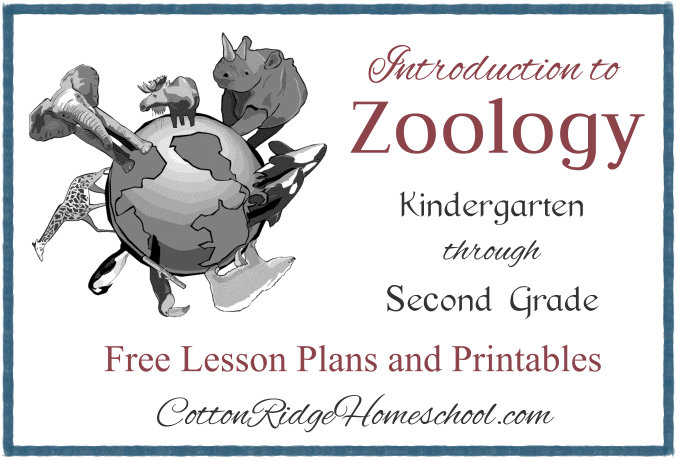
This post is part of the Introduction to Zoology series. For a suggested class schedule, an overview of the entire course, and links to more lesson plans, please see the Introductory Post.
My sincere apologies for the long delay in completing this series of Lesson Plans. I am very sorry for any inconvenience it has caused you! I hope to have the remaining lessons posted by the end of March.
In this lesson you will teach your students about wild cats, including lions, tigers, jaguars, leopards, and more.
Disclosure: I was not compensated for this post. I am an affiliate of Amazon, and will receive a small commission if a link on this page is used to make a purchase.
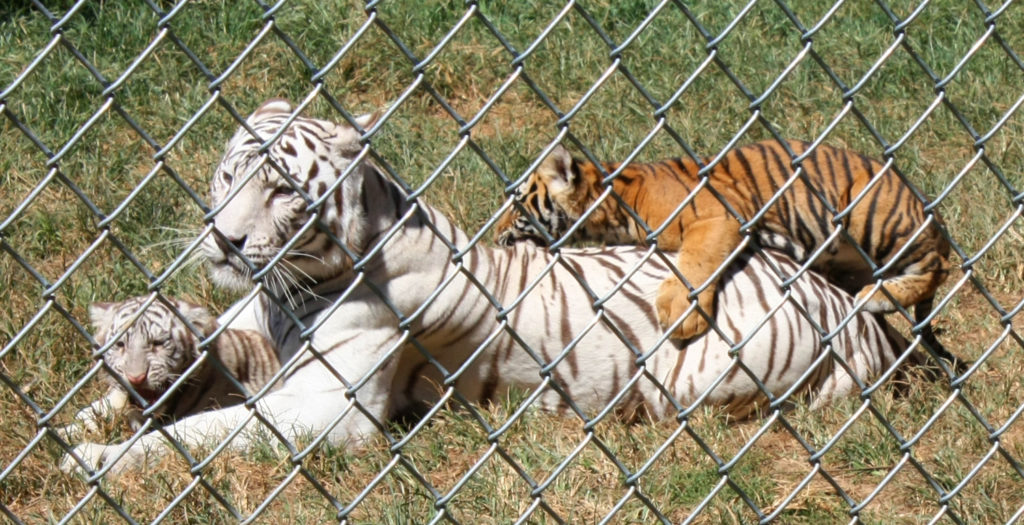
Week 8 Lesson Plan
Note: The following schedule is for a 2-hour class. We also allowed time each week for Show-and-Tell, which is not included below.
1. Introduction & Map Activity (Floor: 5 Minutes)
Wild cats live in many different habitats and countries. They are found on all continents except Antarctica. Check out The Wildcat Sanctuary web site – it has images and information about the 37 different species of cats. (The domestic cat is only one of the 37!)
Place pictures of wild cats on your map this week. For example: a lion in Africa, mountain lion in the western U.S., and a tiger in India.
In my lessons I used the Discovery Kids Fabric Activity Map pictured at the right. I split the felt land mass, water body, and animal pieces into 12 different baggies, one for each lesson. Each week I distributed the felt pieces among my students and allowed them to place them on the map, using a picture of the completed map as a guide.
Alternate Map Idea
The Discovery Kids map appears to be discontinued, so instead, you can use a regular wall map or globe. Cut out small pictures of the animals you are going to learn about from magazines or old encyclopedias. During each lesson attach them to the appropriate area on the map or globe with removable poster putty.
2. Poetry (Floor: 5 Minutes)
The Llama Who Had No Pajama: Ocelet and Tiger (page 63). I chose to read The Llama Who Had No Pajama poem this week, also (page 42). The book is named after this poem. You can choose which week you’d like to read it – perhaps when you study hoofed animals. My students loved this poem! They enjoyed poetry time every week, but I think this one was their favorite.
3. Animal Encyclopedia (Floor: 5 – 10 Minutes)
Read one – four pages from a children’s animal encyclopedia about wild cats – include several different kinds and sizes. Encourage discussion by asking questions such as:
- “What is the most interesting thing you remember?”
- “Did you know there were that many different kinds of wild cats?”
- “Do any of you have a cat for a pet, or have you ever petted a cat? If so, how do you think domesticated cat (house pets) are different from wild cats?”
- “If you see a wild cat or other animal in the woods, your back yard, or at the playground, should you try to pet it? What should you do? (No! Stay away from it. Tell an adult about it.)
I mostly used DK First Animal Encyclopedia, and occasionally Usborne Children’s Encyclopedia of Animals for my lessons.
Use a free Animal Sounds app on your phone or tablet: find the animals you are studying in this lesson and play the sounds for your kids. My students loved this – especially when I let them touch the buttons to play the sounds! If you can’t find the sound for the animal you are studying, try finding some that live in the same habitat.
4. Activity Idea 1: Wild Cats Collage Posters (Table: 10 – 20 Minutes)
Supplies:
- Construction paper or cardstock, One piece for each child
- Pictures of wild cats cut out from magazines, catalogs, or old books and encyclopedias (check used bookstores and consignment sales)
- Glue sticks
This is a simple but fun activity that gives kids practice with using a glue stick.
You can extend this activity by providing magazine pages and catalog pages which have wild cat pictures. For this option, provide scissors so they can cut the pictures out themselves. I personally would not encourage kids of this age to cut out pictures from books, even cheap, old ones. They might get ideas about cutting up books in their families’ personal libraries!
Instruct your students to arrange the pictures as they wish on their papers, overlapping them, gluing them down, and creating a collage (you may need to create a sample and explain “collage”).
5. Activity Idea 2: Backbone Matching Worksheet (Table: 15 – 20 Minutes)
Supplies:
- Worksheet pages printed out for each child (from Hands-On Minds-On Science: Animals)
- Crayons, Markers, Colored Pencils
- Glue Sticks
- Scissors
See finished worksheet below. Follow the instructions in the Hands-On book. (Note: there is a drawing of a boy, as well. Students will choose either the boy or girl to put on their worksheets.)
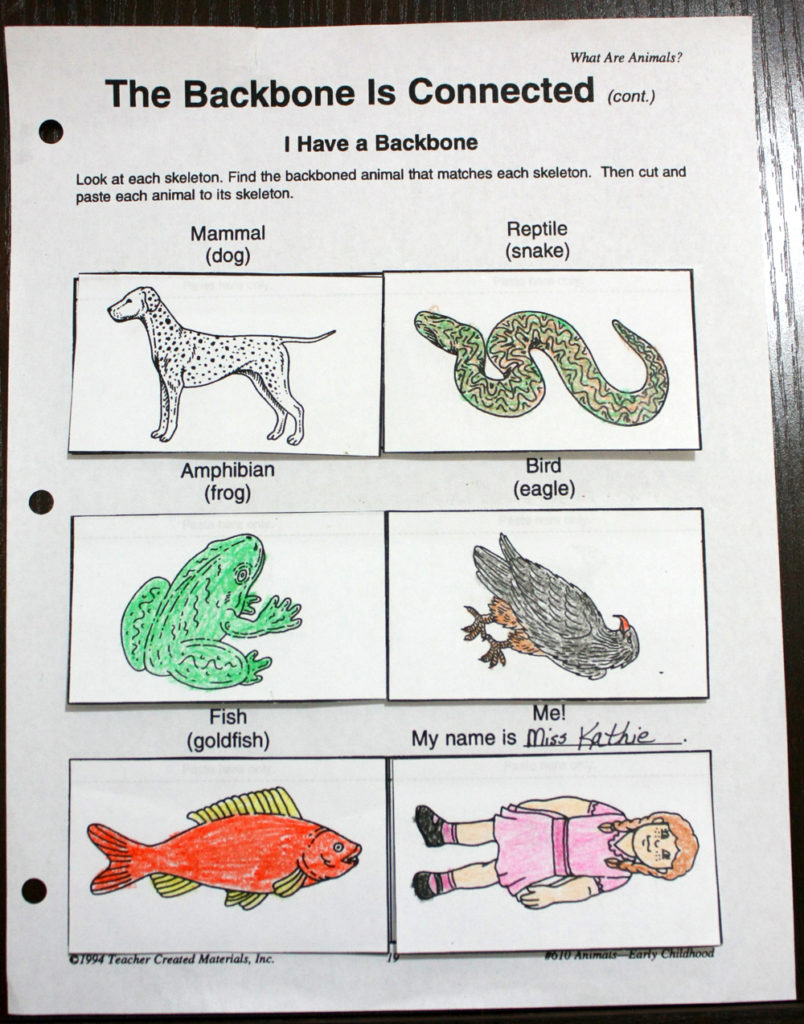
Alternate Activity
The Hands-On book mentioned above is an older book which I found at a consignment sale, but it had such good activities I had to use it! If you cannot find it, you can use the Lion Paper Bag Puppet craft from education.com.
6. Zoology Notebook (Table: 10 – 15 Minutes)
Pass out binders and crayons, markers and/or colored pencils. Have your students color and trace on the Lion page. Click on the thumbnail below to open the free printable PDF file. There are also Lion coloring pages at education.com.
You can assemble the Animal Science Notebooks before the school year begins if you wish: click here for blog post with free printables, instructions, and list of printables.
7. Story and Snack (Table: 10 – 15 Minutes)
Read Christian the Lion from National Geographic Kids Animal Stories.
Snack Ideas
My teaching partner brought in hummus surrounded by cut carrots, cheese sticks, pretzels, and deli meat; it looked like a lion’s mane – very healthy! (Note the cheetah-print napkins!)
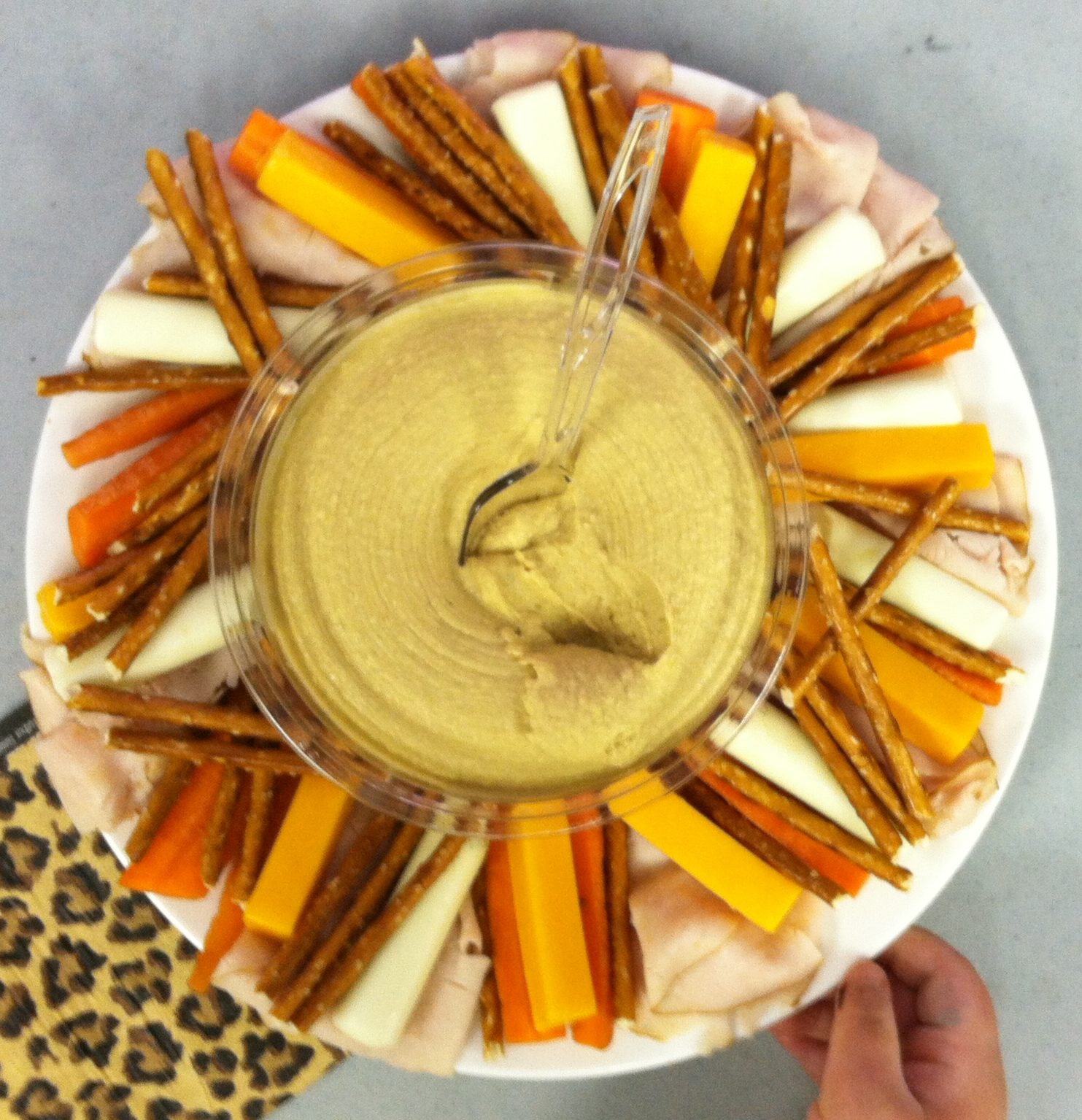
Easy Snack: Goldfish (cats supposedly like fish!)
More involved snack: Use a cat-shaped cookie cutter to make cat-shaped sugar cookies.
Even more involved snack: Provide decorations and icing for the students so they can make cat faces on their cookies.
Be sure to check with your students’ caretakers for any food allergies ahead of time.
For more animal-themed snack ideas, please visit my Science For Kids – Snacks Pinterest board.
8. Craft Project Idea: Lion Mosaic (Table: 15 – 20 Minutes)
My students enjoyed working with the pasta and beans – this is a very sensory project because of all of the different shapes and textures.
Supplies:
- Lion face printable (see below)
- Pasta in various shapes
- Various dried beans
- White glue or tacky glue
- Colored markers, crayons, or colored pencils (optional)
The students can optionally color in the face before they start the mosaic, and just fill in the mane with the pasta and/or beans. If you have more time, you can let them fill in the entire image with the materials. (This is the option we chose, and the kids didn’t finish the project. If I were to do this project again, I’d have them color the face first.)
Click on the thumbnail below to open the free PDF printable.
See my Science For Kids – Life Science Pinterest board for more ideas!
Please feel free to comment below with your recommendations – I appreciate your ideas and suggestions!
Copyright 2018 Kathryn Depew (Text, Images, and Printable PDF Files, except for publishers’ images)
Disclosure: I was not compensated for this post. I am an affiliate of Amazon, and will receive a small commission if a link on this page is used to make a purchase.





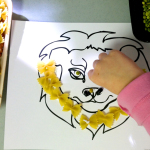

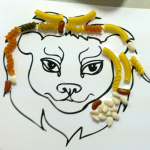

Leave a Reply